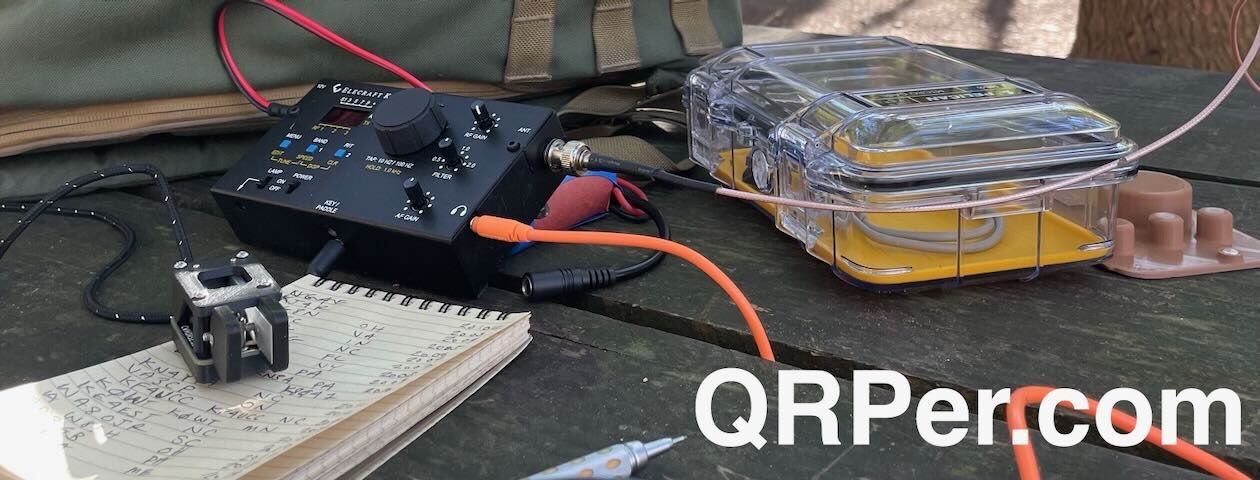February has been a whirlwind of a month. Between juggling projects and my daughters’ incredibly busy senior year of high school, free time has been in short supply.
That said, I’ve made it a goal (for the sake of my own sanity—ha!) to squeeze in as much radio time as possible.
Super Portable POTA
Before October 2023, my go-to radio and antenna combo for quick POTA or SOTA activations was the Elecraft KX2 paired with the AX1 or AX2 antenna.

Even now, I rely on that setup when I want to minimize gear deployment and maximize on-air time. As long as I have a surface to set the radio on—be it a picnic table or my kneeboard–I’m good to go.
 But in October 2023, the Elecraft KH1 changed the game. Designed for handheld operation with virtually zero setup time, this radio has made quick activations even more accessible. Given my current busy schedule, the KH1 has been an absolute lifesaver.
But in October 2023, the Elecraft KH1 changed the game. Designed for handheld operation with virtually zero setup time, this radio has made quick activations even more accessible. Given my current busy schedule, the KH1 has been an absolute lifesaver.
It stays packed in my EDC backpack at all times, ready for an impromptu activation or some portable POTA/SOTA hunting.
A Spontaneous Challenge: 45 Minutes to Activate!
Thursday, February 4, 2025, was a perfect example of this radio’s convenience.
My wife and I had a long list of errands, including dropping off donations at various thrift stores and hurricane relief centers. My wife loves thrift shopping (and volunteering), especially when it comes to browsing clothing sections. As we stopped at one of her favorite large thrift stores to drop off donations, she turned to me and said, “I’d like some time here. Could you do a really quick POTA activation and be back in 45 minutes?”
Without hesitation (I do love a challenge), I said, “Heck yeah!”
Mental Math
I quickly mapped out my plan:
- The nearest POTA entity was the Blue Ridge Parkway (US-3378), about a 5-6 minute drive away.
- I already had a mental spot in mind where I could park and get on the air fast.
- Filming the activation would add at least 3-4 minutes for setting up my camera and audio recorder.
Breakdown of the time constraints:
- Round-trip drive: ~10-12 minutes
- Camera/Audio setup: ~4 minutes
- KH1 setup: ~20 seconds
- Scheduling the activation: ~1 minute
- Remaining activation time: ~29 minutes
Totally doable—as long as nothing went sideways!
A Two-Fer Bonus!
When I arrived at my planned activation spot, I needed only one thing: a place to park. Since the KH1 is fully handheld, I could operate anywhere.

I recalled a small pull-off near the Mountains to Sea Trail (US-8313)—a place I’d used before for a quick hike. If the parking spot was close enough to the MST, this might count as a two-fer.

After arriving on site, I confirmed that I was within 20 feet of the MST. POTA rules require that an activator must be within 100 feet (30.5 meters) of a trail for it to count as an activation–obviously, I was well within those limits.
 Although I could have operated directly from the trail, the MST is a busy single-track trail, and I didn’t want to block hikers. So, I opted to activate from the parking spot instead.
Although I could have operated directly from the trail, the MST is a busy single-track trail, and I didn’t want to block hikers. So, I opted to activate from the parking spot instead.
Next, all I had to do was grab the KH1, set up my camera gear, and hop on the air!
Gear
 Note: All Amazon links are affiliate links that support QRPer.com at no cost to you.
Note: All Amazon links are affiliate links that support QRPer.com at no cost to you.
Radio and Antenna System
- Elecraft KH1 Edgewood Package
- Included 4′ whip antenna and 13′ detachable counterpoise
- Zebra Mini Mechanical Pencil (preferred over the included Zebra pen)
- Pelican Micro M40 mine is the modified version from Tufteln
- Panasonic ErgoFit Wired Earbuds
Camera and Audio Gear
- DJI OSMO 4 action camera with Joby Telepod Sport Tripod
- Sony ICD-FX312 Digital Recorder ($20 thrift store find)
On The Air
 Knowing that 20 meters would likely be the most productive band, I still wanted to experiment on the higher bands first. I started calling CQ POTA on 15 meters and planned to work my way down through 17 meters before finishing on 20 meters. Continue reading Time Crunch: A QRP POTA Activation Challenge and Impromptu Two-Fer!
Knowing that 20 meters would likely be the most productive band, I still wanted to experiment on the higher bands first. I started calling CQ POTA on 15 meters and planned to work my way down through 17 meters before finishing on 20 meters. Continue reading Time Crunch: A QRP POTA Activation Challenge and Impromptu Two-Fer!












































































